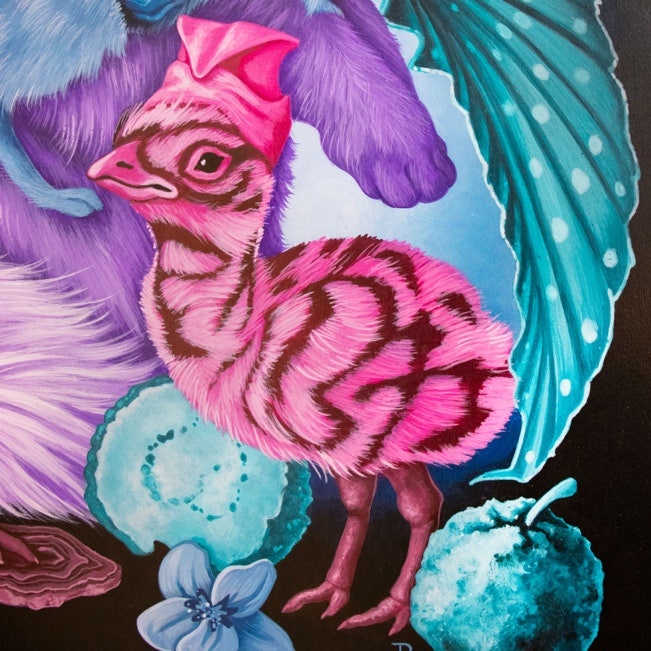Julia Rich is a multifaceted artist, designer, and illustrator based in Melbourne, Australia. Her work is an ever-evolving exploration of cultures and identities that has adapted as she has grown. Through her art, she strikes a balance of Asian-Australian imagery, often infused with positive visuals and humour, and other worldly characters that transport her audience outside the realms of reality.
We recently sat down with Julia to discuss her artistic vision, her unique approach to portraying culture in her work, and to hear her thoughts on the possibilities of generative AI tools and AI generated art.
I’ve been an artist for as long as I can remember. My family always encouraged it, and that momentum continued into my university days. I didn’t think it was possible to be an artist professionally, so I pursued a design degree in fashion instead.
However, after uni, I decided to be brave and give the art thing a shot, since the fashion industry didn’t sit right with me. I went all out and worked on my solo exhibition back in 2014. Ten years later, I'm still here making art full-time, and in a full-circle moment, I’m now working on my second solo exhibition in 2024. It’s been quite a journey!
Initially, my work was a lot more boisterous and punchier – like I had something to prove. I wanted to make noise with both the content and style, which is why I aimed for the loudest possible colour palette. Now that I’m a bit more established, older, and perhaps wiser, I don’t feel that urge anymore.
I’m softer now, and the work reflects that. It's become more meditative, characterised by quiet moments spent repetitively painting stroke by stroke. I find myself indulging in patterns and textures, creating art that's more "cosy" and consumable.
Feeling fairly powerless in terms of my impact on the world, creating cute animals offers a bit of respite for the audience. At least, that's my intention.
Adobe’s new generative AI tools, like Firefly and Generative Fill in Photoshop, have been a major game changer in my drafting and brainstorming process for paintings. Adobe Firefly has helps me come up with reference images and helps me envision ideas that are too specific and niche to search for online.
I recently used Generative Fill in Photoshop when I wanted to generate a Filipino night market, but I wanted it to be in a painted style with a specific colour palette. With a few small prompts, I had that image in seconds to help me solve the planning stage for an upcoming painting.
You’re currently working on your latest exhibition Soft Place – tell us about this.
"Soft Place" explores my Filipino heritage through a child-like fantasy lens, aiming to heal the fragments that occur with generational immigration. The body of work is approached with a tender mindset, often speaking to the healing of the inner child. My intention for the show is to celebrate Filipino culture while infusing it with a uniquely Australian twist. This is depicted through cultural touchstones such as native animals and traditional food dishes.
https://www.instagram.com/p/C6gPXbzun1V/
How does generative AI fit into this story?
Gen AI is aiding in easing the amalgamation of cultures by generating new ideas and providing fresh perspectives. I tend to overthink my art and desperately want it to come off as unique, so sometimes the storytelling can become a little convoluted.
I recently used Adobe Firefly to generate some ideas in the brainstorming process. For example, I was playing around with some anthropomorphic food elements, and Firefly came up with some ideas of traditional Filipino cuisine that I hadn’t considered. It was almost like having a really fast encyclopedia or digital assistant to remind me of things I missed. Gen AI helps me view my ideas from a universal perspective by pinpointing specific symbols and tokens that directly inspire my paintings.
What excites you the most about generative AI?
Having a direct and almost instant sounding board has made the brainstorming and drafting process of creating art seamless. With specific visuals to bounce off, I can start the process of elimination in decision-making. This has halved the drafting time, allowing me to spend more time indulging in the physical art space.
How important is responsible generative AI for you as an artist and why?
I'm very conscious of how I use generative AI in my practice and how I can use the tools for my workflow, but balance needs to be constantly considered. It's important for me as an artist because it feels like we're being listened to. There's a conversation and feedback that's happening, and we need that discourse to ultimately find the best solutions.
https://www.instagram.com/p/C4tyUUhv9LR/
What do you hope to see in the future, and how can your creativity help you achieve this?
With all these new tools, I hope we can break through to having next-level ideas that might have taken us longer to reach previously. I genuinely hope creativity becomes more democratised and mainstream. We're natural inventors, so I hope more people feel excited to create soon.
What advice would you offer to creators starting on their journey?
Put in the hours and research! Learn to be patient. It takes a long time to hone your craft, but consistency is the overarching message. Do a little bit every day and you’ll eventually see the results.
Follow @julia.a.rich as she uses Adobe's Gen AI tools to inform her work for her upcoming show Soft Place'.
Find more creative inspiration and discover the power of generative AI with Adobe Firefly, integrated in Adobe Photoshop and Adobe Express.








